How to Grow Big Gourmet Garlic!
Top Ten Tips for Giant Sized Allium Bulbs!
Do you want to grow prize winning garlic? Would you like to raise really large garlic bulbs? Garlic responds well to optimal growing conditions and with a little special care your crop can increase dramatically in size.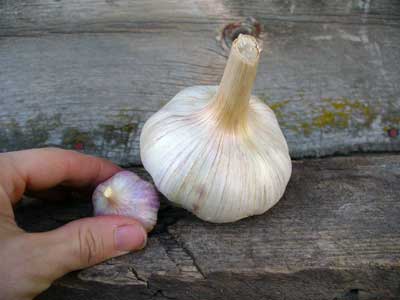
Picture: Tiny but cute Siberian bulb on the left and large elegant German Red bulb on the right. Wouldn't you rather grow the bigger bulb? The smaller bulb was grown using a tiny clove.
With a little effort and some soil preparation, you can grow huge gourmet garlic for top chefs, high end restaurants, CSA’s, Farmer’s Markets or yourself. It takes almost the same effort to cultivate a large as a small bulb.
Hardneck gourmet garlic can sell for $8-$30 pound (depending on market and quality). Careful marketing can offer you the best prices for your crop. See our grow organic garlic page or our Guide to Growing Garlic for some basic techniques and look over these tips to grow superior garlic.
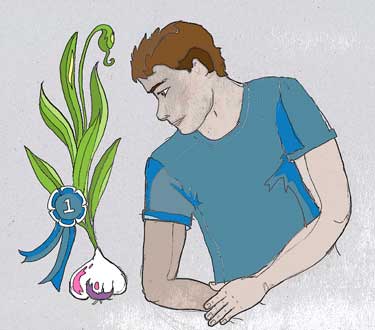 Top Ten Tips for Growing the Biggest and Best Tasting Garlic
Top Ten Tips for Growing the Biggest and Best Tasting Garlic
1) Use good quality large seed garlic:
If you want the biggest bulbs at the county fair start with good quality seed garlic free from disease. Watch out for grocery store garlic; most of it has been treated to inhibit sprouting. Sometimes grocery store garlic is contaminated by garlic white rot fungus (Sclerotium cepivorum). This fungus is lethal to garlic and can remain in the ground for 20-30 years. You don't want to introduce this serious problem to your garden or field.
Start with BIG cloves. When you are selecting cloves for planting eat the smaller cloves and plant the largest cloves. The larger the clove, the larger the garlic bulbs it produces (Madadeen 2011, Mhazo et al. 2014, personal research). We plant our largest cloves each year and are rewarded with huge garlic plants and bulbs. Susan can walk down each row and tell what size clove was planted by the size of the garlic stems (and resulting bulbs).
We have noted that larger cloves are more resistant to adverse conditions and frost. The larger clove has more energy reserves and can outlast bad weather and poor soil drainage. Researchers have noted a correlation between planting clove weight and vigor of resulting plants. Larger sized planting cloves had more vigorous plants with greater leaf area and larger bulb diameter (Stahlschmidt and Cavagnaro 1997, Mhazo et al. 2014).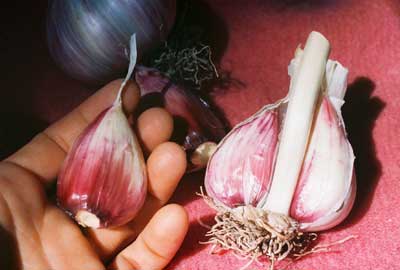
Picture: Romanian Red bulbs typically contain 2-6 extra large cloves.
2) Prepare soil well:
Soil should be loose, loamy and easy to dig. Garlic needs well drained soil or it will rot.
Add manure or compost before fall planting. Our garlic bulbs grow the largest in the area of the field where the soil has been amended to 13% organic matter (using a mix of horse manure in sawdust plus cow manure). German Red especially likes rich soil. The rest of our field is around 6% organic matter and produces well but the bulbs are slightly smaller.
Take a soil test to check for major and minor nutrients. Garlic normally needs extra nitrogen (blood meal is a good organic source of nitrogen). Supplement with nitrogen after planting and several times during the growing season. Stop nitrogen supplementation before garlic scapes in late spring or early summer. Too much nitrogen at this time can cause excess leaf growth at the expense of bulb growth.
Another important supplement is potassium (K). Potassium increases size of bulb and total garlic yield. Volk and Stern (2009) reported that soil potassium concentrations were associated with garlic bulb circumference and fresh bulb weight.
3) Space garlic cloves well apart:
For the biggest garlic, space cloves about 6 inches to 8 inches apart. We space our rows 8 inches apart and space the garlic 6 inches apart within each row. This gives the garlic lots of room to grow. 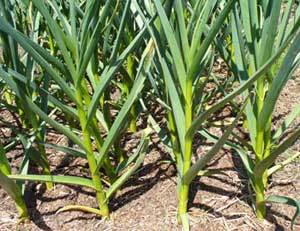
Picture: uniform, well spaced Georgian Crystal garlic plants are easier to weed and grow bigger bulbs.
Some people space their garlic tighter (4 inches is very common). This is fine for smaller cloves but you really want to give large cloves room to spread and develop huge bulbs (Castellanos et al. 2004)! Note: The wider spacing is especially useful for dryland farming (which we do) since it allows more moisture for each plant.
4) Mulch gourmet garlic well:
Mulching protects from winter weather, help prevent weeds, conserve moisture and keep the soil cool longer. Garlic likes cool soil. You can use straw (make sure it is free of weeds), wood chips or compost. Thicker mulches prevent weed growth.
Be careful of straw or hay mulches in wet climates or wet years. Heavy mulches may contribute to stem rot. In addition, hay from grain crops like wheat may carry stem rots that can transfer to garlic. If you notice signs of stem rot (browning or sliminess around the base of the plant), rake the mulch away from the garlic stalk. We have not noticed this problem with compost based mulches.
5) Take precautions based on your climate:
Garlic adapts to where it is grown. Bulb wrapper color and intensity vary depending on where garlic is grown (Volk and Stern 2009). This is called 'phenotypic plasticity'. We also notice a difference in garlic bulb color depending on the year. For example, this year (2013 harvest) our German Red had white striped wrappers. Normally the German Red is much darker with red and brown tones.
Tips for Southern Growers: People in the South have special challenges. See our Southern Garlic Grower’s Guide for a guide on growing garlic in the South. 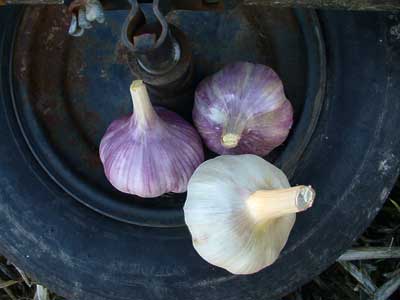
Picture: Garlic color diversity can be seen in the contrast between a light colored German Red bulb flanked by two very purple Chesnok Red bulbs.
Tips for Northern Growers: Hardneck garlic does best in the North but needs to be protected against temperature extremes. Make sure to plant deep (5-6 inch deep hole) and mulch well with fluffy straw, compost or wood chips. Fluff up straw to make sure it doesn't make dense mats on the ground which can prevent garlic from emerging. Plant several weeks after the first killing frost (we plant near the end of October).
You can grow all the hardneck varieties if they are protected during the winter. Thermadrone and other softnecks are the most ‘iffy’ in really cold climates. These varieties may have some cloves that don't survive the winter. We are noticing that Lorz Italian is a much more cold hardy softneck.
6) Don’t forget to weed:
Garlic yield can be reduced by over half due to weeds! When we first started raising garlic a small portion of the field got away from us and resulted in a weed tangle. Those were the smallest bulbs I have ever seen. I still keep a handful of those bulbs to remind myself that weeding pays. Mulching can help prevent weeds, too.
7) Remove scapes or garlic false seedheads: 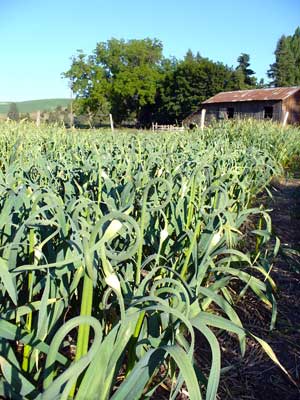
Picture: A field of scaping garlic. Hardneck garlic produces false seedheads called scapes. Scapes contain bulblets but not true seeds. You can plant the small bulblets but they will take 2-3 years to become full sized.
Garlic produces a false seedhead called a scape on a long flower stalk. Scapes will develop into small bulblets. Cut off scapes when they first appear and curl.
Scapes can be sold at Farmer’s Markets and to chefs. They are considered a culinary delicacy. Removing the scapes may result in bigger bulbs as well since the plants energy is concentrated on developing the bulb and not the bulbils in the scape.
8) Harvest at the right time: 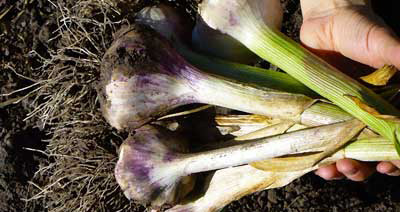
Picture: Large softneck Thermadrone garlic bulbs just after harvest. Note soil clinging to bulbs. This should be brushed off before bulbs are cured. Typically, smaller bulbs need to be harvested sooner than larger bulbs.
Hardneck garlic should be harvested when approximately one third to one half the leaves are brown. Softneck garlic should be harvested when the bottom leaves begin turning brown or the garlic falls over (usually when the bottom 3 leaves are brown).
Harvest too early and the garlic will not have formed wrappers around the cloves yet. Harvest too late and the wrappers on the outside of the bulb will degenerate and bulb quality and keeping ability will be poor. For pictures of garlic ready to harvest see common garlic questions.
Clean or brush excess soil off of garlic and garlic roots right after harvest. This is important to help get air flow to the bulb and it keeps everything much cleaner.
9) Protect garlic from the sun after harvest.
Hardneck garlic can get sunburned so place it in a shady area as you harvest. We put towels on our piles in the field if the sun is really intense. Make sure to cure garlic in a shady area.
10) Cure garlic for the best taste and keeping qualities.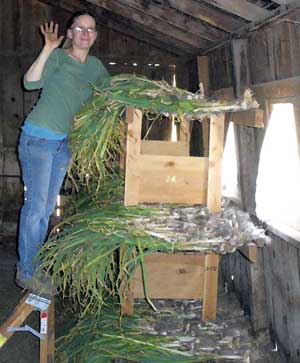

Picture: Patty arranges hardneck garlic on homemade wood racks for drying. Note: she is leaning on her step stool which we don't advise! Patty just happens to be very agile.
Cure garlic in a dry, cool area out of direct sunlight for 4-6 weeks. The garlic will become lighter as it dries and its flavors will mellow and develop. Garlic straight from the field has a green flavor. After curing, store garlic at 50 F, with 55-65% humidity.
Many growers hang their garlic but we have always used racks. It may be because some of us are too prone to hitting our heads on low hanging objects. You can hang garlic to dry but if you raise large amounts of the tasty allium racks will be much easier and faster. We have also spread garlic to dry on clean pallets (which allow airflow from underneath).
References:
- Castellanos JZ, Vargas-Tapia P, Ojodeagua JL, Hoyos G. Garlic productivity and profitability as affected by seed clove size, planting density and planting method. HortScience. 2004;39:1272-1277. Full text.
- Mahadeen AY. Influence of Clove Weight on Vegetative Growth and Yield of Garlic (Allium sativum L.) Grown under Drip Irrigation. Jordan Journal of Agricultural Sciences. 2011;7:44-50. Full text.
- Mhazo ML. Ngwerume FC, Masarirambi MT. Garlic (Allium sativum) Propagation Alternatives using Bulblets and Cloves of Different Sizes in a Semi-arid Sub-tropical Environment. Annual Research & Review in Biology. 2014; 4: 238-245. Full text available by PDF download if you Google the title.
- Stahlschmidt OM, Cavagnaro JB, Borgo R. Influence of planting date and seed clove size on leaf area and yield of two garlic cultivars (Allium sativum L.). Acta Hort. 1997;433:519–522. ISHS.
- Volk GM, Stern D. Phenotypic Characteristics of Ten Garlic Cultivars Grown at Different North American Locations. HortScience August 2009;44: 1238-1247. Full text.
